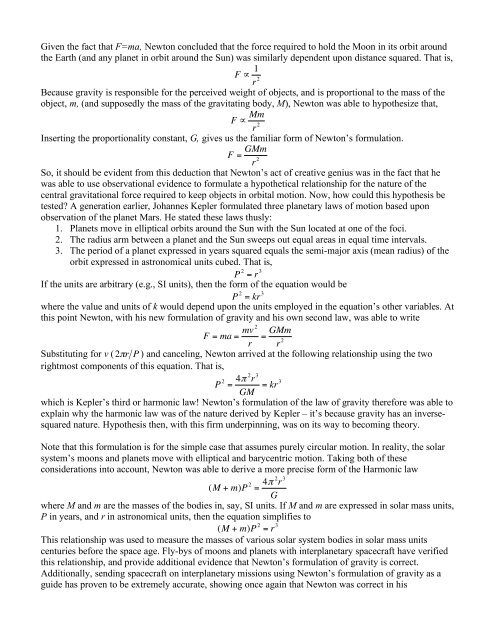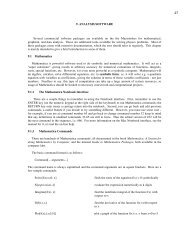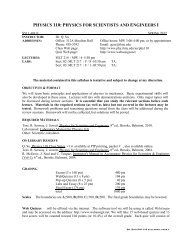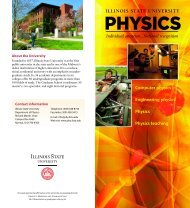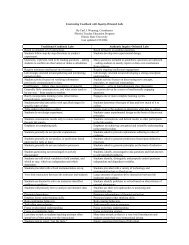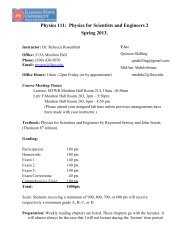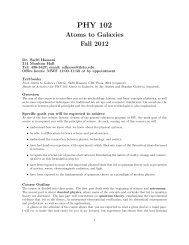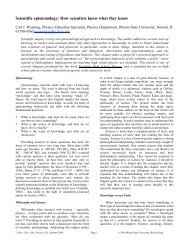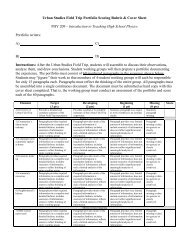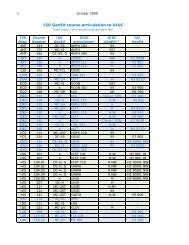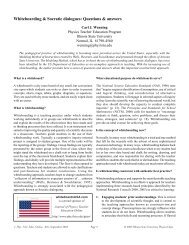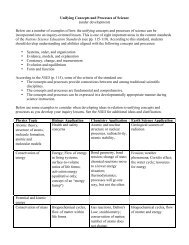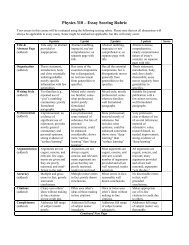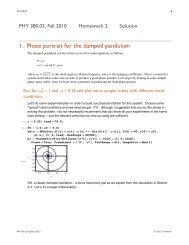The Creative Genius of Isaac Newton - Illinois State University
The Creative Genius of Isaac Newton - Illinois State University
The Creative Genius of Isaac Newton - Illinois State University
Create successful ePaper yourself
Turn your PDF publications into a flip-book with our unique Google optimized e-Paper software.
Given the fact that F=ma, <strong>Newton</strong> concluded that the force required to hold the Moon in its orbit around<br />
the Earth (and any planet in orbit around the Sun) was similarly dependent upon distance squared. That is,<br />
F " 1 r 2<br />
Because gravity is responsible for the perceived weight <strong>of</strong> objects, and is proportional to the mass <strong>of</strong> the<br />
object, m, (and supposedly the mass <strong>of</strong> the gravitating body, M), <strong>Newton</strong> was able to hypothesize that,<br />
! F " Mm<br />
r 2<br />
Inserting the proportionality constant, G, gives us the familiar form <strong>of</strong> <strong>Newton</strong>’s formulation.<br />
F = GMm<br />
r 2<br />
So, it should be evident from this deduction<br />
!<br />
that <strong>Newton</strong>’s act <strong>of</strong> creative genius was in the fact that he<br />
was able to use observational evidence to formulate a hypothetical relationship for the nature <strong>of</strong> the<br />
central gravitational force required to keep objects in orbital motion. Now, how could this hypothesis be<br />
!<br />
tested? A generation earlier, Johannes Kepler formulated three planetary laws <strong>of</strong> motion based upon<br />
observation <strong>of</strong> the planet Mars. He stated these laws thusly:<br />
1. Planets move in elliptical orbits around the Sun with the Sun located at one <strong>of</strong> the foci.<br />
2. <strong>The</strong> radius arm between a planet and the Sun sweeps out equal areas in equal time intervals.<br />
3. <strong>The</strong> period <strong>of</strong> a planet expressed in years squared equals the semi-major axis (mean radius) <strong>of</strong> the<br />
orbit expressed in astronomical units cubed. That is,<br />
P 2 = r 3<br />
If the units are arbitrary (e.g., SI units), then the form <strong>of</strong> the equation would be<br />
P 2 = kr 3<br />
where the value and units <strong>of</strong> k would depend upon the units employed in the equation’s other variables. At<br />
this point <strong>Newton</strong>, with his new formulation ! <strong>of</strong> gravity and his own second law, was able to write<br />
! F = ma = mv 2<br />
= GMm<br />
r r 2<br />
Substituting for v ( 2"r P ) and canceling, <strong>Newton</strong> arrived at the following relationship using the two<br />
rightmost components <strong>of</strong> this equation. That is,<br />
! P 2 = 4" 2 r 3<br />
!<br />
GM = kr 3<br />
which is Kepler’s third or harmonic law! <strong>Newton</strong>’s formulation <strong>of</strong> the law <strong>of</strong> gravity therefore was able to<br />
explain why the harmonic law was <strong>of</strong> the nature derived by Kepler – it’s because gravity has an inversesquared<br />
nature. Hypothesis then, with this firm underpinning, was on its way to becoming theory.<br />
!<br />
Note that this formulation is for the simple case that assumes purely circular motion. In reality, the solar<br />
system’s moons and planets move with elliptical and barycentric motion. Taking both <strong>of</strong> these<br />
considerations into account, <strong>Newton</strong> was able to derive a more precise form <strong>of</strong> the Harmonic law<br />
(M + m)P 2 = 4" 2 r 3<br />
G<br />
where M and m are the masses <strong>of</strong> the bodies in, say, SI units. If M and m are expressed in solar mass units,<br />
P in years, and r in astronomical units, then the equation simplifies to<br />
(M + m)P 2 = r 3<br />
This relationship was used to measure<br />
!<br />
the masses <strong>of</strong> various solar system bodies in solar mass units<br />
centuries before the space age. Fly-bys <strong>of</strong> moons and planets with interplanetary spacecraft have verified<br />
this relationship, and provide additional evidence that <strong>Newton</strong>’s formulation <strong>of</strong> gravity is correct.<br />
Additionally, sending spacecraft on ! interplanetary missions using <strong>Newton</strong>’s formulation <strong>of</strong> gravity as a<br />
guide has proven to be extremely accurate, showing once again that <strong>Newton</strong> was correct in his


